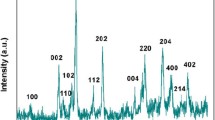Abstract
A complementary metal oxide semiconductor (CMOS) image sensor was utilized to detect the interaction of cardiovascular disease markers, troponin I and C-reactive protein. Each marker with its respective antibodies was adsorbed to an indium nanoparticle (InNP)-coated glass substrate. Dielectric layers of antigens and antibodies bound onto and interacted on conducting InNPs. Normal room light passed through these protein-layer-bound substrates and hit the CMOS image sensor surface, and the number of photons was detected and converted into digital form. We tested this approach for real-time monitoring of cardiac disease markers based on photon count, demonstrating its low cost and its capacity to detect antigens with high sensitivity at picogram per milliliter concentration.







Similar content being viewed by others
References
Isoda T, Urushibara I, Sato M, Uemura H, Sato H, Yamauchi N (2008) Sens Actuators B Chem 129:958–970
Xue Z, Qiu H (2005) Sens Actuators A Phys 122:189–195
Zivojinovic P, Lescure M, Tap-Beteille H (2004) Sens Actuators A Phys 115:273–279
Ciudad D, Aroca C, Sanchez MC, Lopez E, Sanchez P (2004) Sens Actuators A Phys 115:408–416
Kandasamy K, Marimuthu M, Sung GY, Ahn CG, Kim S (2010) Anal Sci 26:1215–1217
Stadler V, Beyer M, Konig K, Nesterov A, Torralba G, Lindenstruth V, Hausmann M, Ralf Bischoff F, Breitling F (2007) J Proteome Res 6:3202–3197
Wang Y, Xu C, Li J, Hsing IM, Chan M (2005) Solid-State Electron 49:1933–1936
Ardeshirpour Y, Deen MJ, Shirani S (2004) Can J Elect Comput E 29:231–235
Maruyama Y, Sawada K, Takao H, Ishida M (2006) IEEE Trans Electron Devices 53:553–558
Jeon SI, Lee JH, Andrade JD, de Gennes PG (1991) J Colloid Interface Sci 142:149–158
Giaever I (1973) J Immunol 110:1424–1426
Oh SW, Moon JD, Park SY, Jang HJ, Kim JH, Nahm KB, Choi EY (2005) Clin Chim Acta 356:172–177
Ahn JS, Choi S, Jang SH, Chang HJ, Kim HJ, Nahm KB, Oh SW, Choi EY (2003) Clin Chim Acta 332:51–59
Bertoncello P, Forster RJ (2009) Biosens Bioelectron 24:3191–3200
Walker JW (2006) J Mol Cell Cardiol 40:446–450
Miao WJ (2004) Chem Rev 108:2506–2553
Bertoncello P (2011) Front Biosci 16:1084–1108
Katus HA, Remppis A, Looser S, Hallermayer K, Scheffold T, Kfibler W (1989) J Mol Cell Cardiol 21:1349–1353
Pagani F, Serena C, Bosio C, Cuccia C, Panteghini M (2001) Clin Chem Lab Med 39:458–459
Marimuthu M, Kandasamy K, Ahn CG, Sung GY, Kim MG, Kim S (2011) Anal Bioanal Chem. doi:10.1007/s00216-011-5231-9
Giaever I, Laffin RJ (1974) Proc Natl Acad Sci USA 71:4533–4535
Dragan AI, Geddes CD (2010) J Appl Phys 108:094701–094707
Schalkhammer T (1998) Monatsh Chem 129:1067–1092
Acknowledgement
This work was supported by the WCU Program (R33-2010-000-10067-0) of Korean Ministry of Education & Science Technology and further supported by the Industrial Strategic Technology Development Program (10035197) funded by the Ministry of Knowledge Economy of Korea and by the Public welfare & Safety research program through the National Research Foundation of Korea (NRF) funded by the Ministry of Education, Science and Technology (2011-0021115).
Author information
Authors and Affiliations
Corresponding authors
Rights and permissions
About this article
Cite this article
Devadhasan, J.P., Marimuthu, M., Kim, S. et al. A CMOS image sensor to recognize the cardiovascular disease markers troponin I and C-reactive protein. Anal Bioanal Chem 402, 813–821 (2012). https://doi.org/10.1007/s00216-011-5478-1
Received:
Revised:
Accepted:
Published:
Issue Date:
DOI: https://doi.org/10.1007/s00216-011-5478-1




